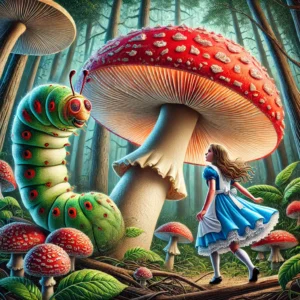Introduction: Exploring the Symbolism and Psychedelic Interpretations
The imagery of mushrooms in ‘Alice in Wonderland’ has long fascinated readers and scholars alike. One particular mushroom, the Amanita muscaria, also known as the fly agaric, has been frequently associated with the surreal and dreamlike experiences of Lewis Carroll’s world. While Carroll himself may not have explicitly referenced this or other psychedelic substances, modern interpretations often draw parallels between the whimsical events in Wonderland and the effects of such mushrooms.
Mushrooms in ‘Alice in Wonderland’: A Closer Look at Amanita Muscaria
Amanita muscaria is one of the most recognizable mushrooms, often depicted with its iconic red cap and white spots. This mushroom has long been associated with altered states of consciousness and is commonly referenced in folklore, mythology, and modern psychedelic culture.
1. Amanita Muscaria and the Mushroom in Wonderland:
- Fact: In ‘Alice in Wonderland,’ the mushroom that Alice encounters while speaking with the Caterpillar is never named, but many have speculated that it may be inspired by Amanita muscaria. The Caterpillar tells Alice that eating from one side of the mushroom will make her grow larger, while the other side will make her smaller. This duality of effects mirrors the unpredictable experiences associated with consuming Amanita muscaria, which has both hallucinogenic and toxic properties.
- Fiction: Although some believe Carroll was directly referencing the psychedelic effects of Amanita muscaria, there is no concrete evidence that Carroll had any knowledge of its psychoactive properties. However, the mushroom’s role in altering Alice’s perception of reality has fueled these interpretations.
The Role of Psychedelics in Modern Interpretations
The association between ‘Alice in Wonderland’ and psychedelics has grown over time, particularly with the rise of the counterculture movement in the 1960s. During this era, the novel was frequently interpreted as an allegory for the psychedelic experience, with Alice’s shifting perceptions seen as metaphors for the effects of mind-altering substances.
1. The Psychedelic Influence in Popular Culture:
- Fact: The 1960s counterculture movement, which embraced the use of psychedelics such as LSD and psilocybin mushrooms, drew heavily on the imagery and themes of ‘Alice in Wonderland.’ The novel became a symbol for the exploration of altered consciousness, and references to it appeared in music, art, and film during this period.
- Fiction: It is a common misconception that ‘Alice in Wonderland’ was written with psychedelic experiences in mind. In reality, the book was published in 1865, long before the discovery and popularization of substances like LSD. However, the story’s dreamlike and surreal elements have made it a natural fit for these later interpretations.
Amanita Muscaria: History and Usage
Amanita muscaria has been used for centuries in religious and cultural rituals across various regions, particularly in Siberia, where shamans reportedly consumed the mushroom to induce visions and altered states of consciousness. These practices may have influenced modern psychedelic culture’s fascination with the mushroom and its association with ‘Alice in Wonderland.’
1. Amanita Muscaria in Shamanic Practices:
- Fact: The mushroom was traditionally used in Siberian shamanism, where it was consumed to facilitate spiritual journeys and communicate with the spirit world. The mushroom’s hallucinogenic effects were thought to allow shamans to enter altered states of perception, providing insight and guidance.
- Fiction: Although Amanita muscaria is often associated with hallucinations, it is not as widely used recreationally as other psychedelics like psilocybin mushrooms. The mushroom can cause unpleasant side effects, such as nausea and delirium, and its effects are less predictable.
Fictional Elements: The Mythology of Psychedelics in ‘Alice in Wonderland’
The influence of psychedelic culture has shaped the way ‘Alice in Wonderland’ is interpreted, particularly in regard to the mushrooms Alice encounters on her journey.
1. The Myth of Carroll’s Intentions:
- Fiction: It is a widespread myth that Lewis Carroll wrote ‘Alice in Wonderland’ under the influence of drugs or intended the story to be a commentary on drug use. This misconception likely stems from the surreal, dreamlike nature of the book, which can resemble the effects of psychedelic experiences.
- Fact: Lewis Carroll was a mathematician, logician, and writer who created ‘Alice in Wonderland’ as a children’s fantasy story. While the book’s imagery has been adopted by psychedelic culture, Carroll himself had no known association with drugs or mind-altering substances.

Conclusion: The Intersection of Literature, Mushrooms, and Psychedelic Culture
The connection between ‘Alice in Wonderland’ and mushrooms, particularly the Amanita muscaria, has evolved into a fascinating cultural and symbolic phenomenon. While Lewis Carroll likely did not intend to reference psychedelic experiences, the surreal imagery and transformative nature of Wonderland have made the novel a lasting symbol in modern psychedelic culture. The mushroom, whether viewed as a literary device or a symbol of transformation, continues to captivate readers and inspire new interpretations.


